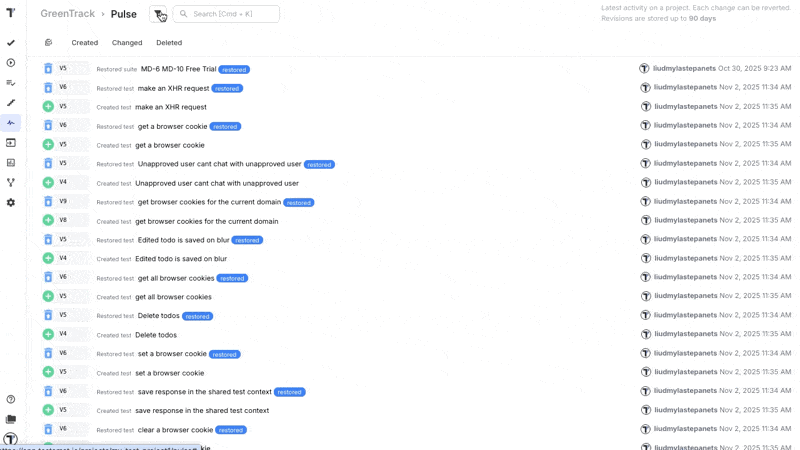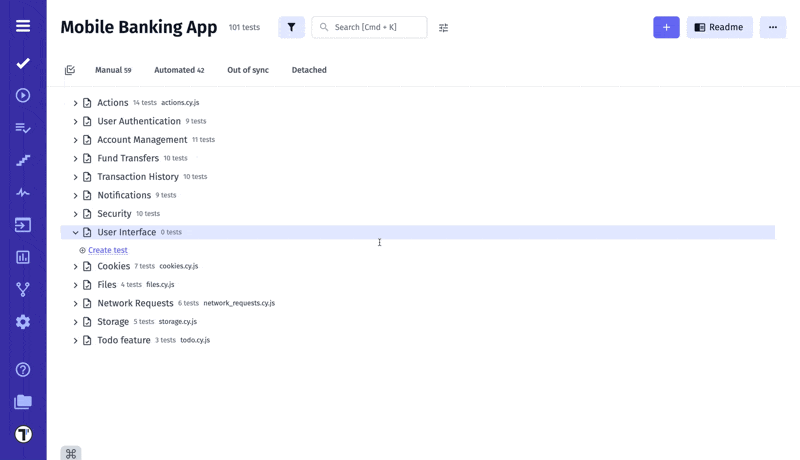Pulse
Introducing Pulse
Section titled “Introducing Pulse”Pulse is a powerful feature in Testomat.io that brings full visibility, traceability, and control to your QA workflow. It tracks every change made within your projects — from new test creation to updates and deletions — giving you a clear picture of how your testing assets evolve over time.
Pulse provides instant insight into team activity and testing progress, helping QA Leads and Project Managers stay informed without manually requesting status updates.
What is Pulse
Section titled “What is Pulse”Pulse acts as your project’s activity log and version history, automatically recording all modifications across test cases, test suites, and folders. It’s designed to ensure transparency, accountability, and easy recovery, so your team can work confidently knowing that every action is tracked and reversible.
With Pulse, you can:
- See who made a change, what was changed, and when it happened.
- Review the the history of edits, additions, or deletions for any test or suite.
- Restore deleted items or roll back to previous versions with a single click.
For QA Engineers, this means full control over versioned work. For managers, it offers a reliable audit trail and a clear view of project momentum over time.
This ensures you’ll never lose important test data or struggle to understand how your project has evolved — Pulse keeps your QA process transparent and your history intact.
How Pulse Works
Section titled “How Pulse Works”You can access Pulse directly from the Pulse tab in your Testomat.io project. There, you’ll find a chronological list of all activities recorded over the last 90 days. Each entry contains detailed information about the change, including timestamps, item type, and the responsible team member.
Activity Types
Section titled “Activity Types”Pulse categorizes changes into three main types, accessible via separate tabs:
- Created — new tests, test suites, or folders added to the project.
- Changed — updates to existing items, such as editing test descriptions, modifying states (e.g., from Automated to Detached), or renaming a suite.
- Deleted — items removed from the project, including tests, suites, or entire runs.
Every recorded event provides a clear snapshot of the change and supports rollback functionality, so you can revert to a previous version or recover deleted items when needed.
QA Leads can use this overview to identify active contributors, while PMs can quickly assess whether recent changes align with sprint goals or release timelines.

Filtering and Navigation
Section titled “Filtering and Navigation”Pulse includes powerful filters to help you quickly find the information you need. You can narrow down activities based on:
- Item Type – view only tests or suites.
- Date Range – filter changes within a specific time window.
- Changed By – see actions performed by a particular user.
Each filter can be applied individually or in combination, enabling precise tracking of team activity and project evolution.
This makes it easy to monitor specific team members’ contributions or isolate changes from a given testing phase.

Bulk Restore
Section titled “Bulk Restore”Bulk Restore is a great extension for Pulse. It is designed to save you time and effort by allowing you to restore multiple deleted tests and suites at once.
With Bulk Restore, you can:
-
Batch Restore: Quickly and efficiently recover multiple deleted tests and suites at once, eliminating the need to restore each item individually.
-
Multi-Selection Mode: Easily activate multi-select mode, choose the tests and suites you wish to restore, and bring them all back with a single action.
